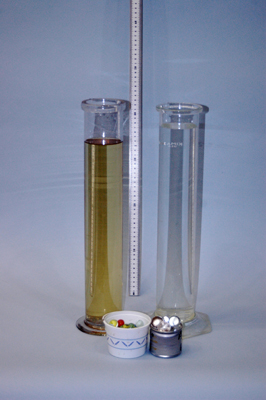|
Size: 1804
Comment:
|
← Revision 12 as of 2013-07-12 18:18:25 ⇥
Size: 2967
Comment: converted to 1.6 markup
|
| Deletions are marked like this. | Additions are marked like this. |
| Line 2: | Line 2: |
| ||<:30%>[:PiraScheme#FluidMechanics: Table of Fluid Mechanics Demonstration]||<:30%>List of Fluid Mechanics Equipment & Supplies]||<:30%>[:Demonstrations:Lecture Demonstrations]|| | ||<:30%>[[PiraScheme#FluidMechanics| Table of Fluid Mechanics Demonstration]]||<:30%>List of Fluid Mechanics Equipment & Supplies||<:30%>[[Demonstrations|Lecture Demonstrations]]|| |
| Line 6: | Line 6: |
| '''Topic and Concept:''' Motion in One Dimension, [[MotionIn1D#Velocity| 1C10. Velocity]] |
|
| Line 7: | Line 10: |
| * '''Cabinet:''' [:FluidMechanicsCabinet:Fluid Mechanics (FM)] * '''Bay:''' [:FluidMCabinetBayA5:A5] |
* '''Cabinet:''' [[FluidMechanicsCabinet|Fluid Mechanics (FM)]] * '''Bay:''' [[FluidMCabinetBayA5|A5]] |
| Line 11: | Line 14: |
| attachment:GlycerinViscosity-01-400.jpg | {{attachment:GlycerinViscosity-01-400.jpg}} |
| Line 13: | Line 16: |
| '''Description:''' | '''Abstract:''' |
| Line 25: | Line 28: |
| A. '''''Don't spill the glycerin - it's difficult to clean up.''''' | * '''''Don't spill the glycerin - it's difficult to clean up.''''' |
| Line 28: | Line 31: |
| '''Setup:''' | '''Setup and Procedure:''' |
| Line 31: | Line 34: |
| 2. Place cylinders on table side-by-side. 3. Have marbles ready to be dropped. |
1. Place cylinders on table side-by-side. 1. Grab two marbles of identical size and weight. 1. Hold one marble in each hand above each cylinder. 1. From the same height, drop each marble at the same time, and observe the velocity differences. |
| Line 34: | Line 39: |
| '''Demonstration:''' | |
| Line 36: | Line 40: |
| Grab two marbles of identical size and weight. Hold one marble in each hand above each cylinder. From the same height, drop each marble at the same time, and observe the velocity differences. | '''Cautions, Warnings, or Safety Concerns:''' * N/A '''Discussion:''' Suppose there is a body being accelerated by two opposing forces. One of these forces is constant, and the other is velocity-dependent. There will be a point in the body's trajectory when the two forces exactly cancel, and the body is no longer accelerating. The velocity at which this occurs is called the body's terminal velocity. Such velocity-dependent forces frequently occur in fluids such as air and glycerol in the form of resistance. Glycerol is a highly viscous fluid which means it is resistant to flowing. Thus, the resistance force on the marbles quickly reaches a point when gravity is just balanced. In a less viscous fluid such as water, it takes longer to reach this point. '''Videos:''' * [[https://www.youtube.com/user/LectureDemostrations/videos?view=1|Lecture Demonstration's Youtube Channel]] * [[attachment:Oil-1.avi]] Slow Motion Video of 3/16, 7/36, and 9/36 ball barrings in Glycerol |
| Line 40: | Line 55: |
http://en.wikipedia.org/wiki/Glycerol http://en.wikipedia.org/wiki/Terminal_velocity http://en.wikipedia.org/wiki/Viscosity |
* [[http://en.wikipedia.org/wiki/Glycerol|Glycerol - Wikipedia]] * [[http://en.wikipedia.org/wiki/Terminal_velocity|Terminal Velocity - Wikipedia]] * [[http://en.wikipedia.org/wiki/Viscosity|Viscosity - Wikipedia]] |
| Line 46: | Line 60: |
| [:Instructional:Home] | [[Instructional|Home]] |
List of Fluid Mechanics Equipment & Supplies |
Terminal Velocity With Water, Glycerin, & Marbles, 2C30.50 and 1C10.51
Topic and Concept:
Motion in One Dimension, 1C10. Velocity
Location:
Cabinet: Fluid Mechanics (FM)
Bay: A5
Shelf:1

Abstract:
Two identical marbles are dropped simultaneously into separate graduated cylinders, one filled with glycerine and the other with water. The marble dropped in glycerine will quickly reach terminal velocity, obtaining a slow and constant velocity that can be measured.
Equipment |
Location |
ID Number |
|
|
|
Graduated cylinder filled with water |
FM, Bay A5, Shelf #1 |
|
Graduated cylinder filled with glycerin |
FM, Bay A5, Shelf #1 |
|
Marbles |
FM, Bay A5, Shelf #1 |
|
Important Setup Notes:
Don't spill the glycerin - it's difficult to clean up.
Setup and Procedure:
- Fill non-glycerin cylinder with water so that fluid height levels in each cylinder match.
- Place cylinders on table side-by-side.
- Grab two marbles of identical size and weight.
- Hold one marble in each hand above each cylinder.
- From the same height, drop each marble at the same time, and observe the velocity differences.
Cautions, Warnings, or Safety Concerns:
- N/A
Discussion:
- Suppose there is a body being accelerated by two opposing forces. One of these forces is constant, and the other is velocity-dependent. There will be a point in the body's trajectory when the two forces exactly cancel, and the body is no longer accelerating. The velocity at which this occurs is called the body's terminal velocity. Such velocity-dependent forces frequently occur in fluids such as air and glycerol in the form of resistance. Glycerol is a highly viscous fluid which means it is resistant to flowing. Thus, the resistance force on the marbles quickly reaches a point when gravity is just balanced. In a less viscous fluid such as water, it takes longer to reach this point.
Videos:
Oil-1.avi Slow Motion Video of 3/16, 7/36, and 9/36 ball barrings in Glycerol
References: